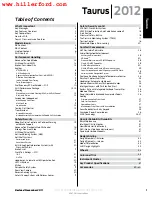
9
Revised September 2011
esourcebook.dealerconnection.com
RE&T: 2012 Source Book
Ta
urus
Taurus
Performance/Handling
2012
Engines cont’d
ENgINEERINg INSIgHT
EcoBoost gasoline Direct Injection
• Direct injection is a key technology behind the
performance capability and fuel efficiency of the
3.5L EcoBoost V6 engine
• Fuel is injected directly into the combustion
chamber of each cylinder by solenoid-controlled
high-pressure injectors, compared to traditional
fuel injection where fuel is mixed with intake air
prior to entering the chamber
– Fuel is pumped from the tank at a normal
pressure of around 200 psi to the engine
compartment
– A cam-driven high-pressure fuel pump increases
fuel pressure to around 2150 psi, depending on
the demands of the engine
• Direct-injection fuel injectors are positioned on the
side of the combustion chamber
• Each injector delivers a precise fuel spray into each
cylinder, allowing a higher compression ratio to
help improve engine performance and reduce fuel
consumption
• An electronic control system varies the timing
and intensity of the fuel delivery according to the
engine’s operating conditions
• Precise control of the fuel provides:
– Increased protection against engine knock/
detonation to help allow for improved
performance and excellent transient response
– Great balance of performance and fuel economy
—
the power of a V8 in a V6 package
ENgINEERINg INSIgHT
EcoBoost Twin Turbochargers
• A turbocharger uses otherwise wasted energy from
the engine’s exhaust to rotate a turbine wheel
• The turbine wheel is coupled to a compressor that
pressurizes air coming into the engine — this is
called “boost” and allows the engine to breathe in
air as if it were larger in displacement since more air
is “forced” into the intake
• The more air an engine breathes, the more power
it generates
• The twin turbochargers are each about the size of
a large orange
• A twin-turbo design offers many benefits compared
to a larger, single-turbo approach
– Compact design and low NVH (Noise, Vibration
and Harshness) characteristics
– Less engine compartment heat
– Turbo lag is virtually eliminated — the turbos will
spool up faster than a single-turbo engine and
allow the 3.5L EcoBoost V6 to reach peak power
faster than a single-turbo design
– Drivers will feel an immediate response when they
step on the accelerator
• Combined with gasoline direct injection, the twin-
turbo design allowed the Ford engineers to generate
V8-like power
Aggressive Deceleration Fuel Shut-off (ADFSO)
• Helps maximize fuel efficiency by temporarily
interrupting fuel delivery and consumption when
the vehicle normally slows down while maintaining
normal engine operation
• System is automatic and requires no interaction from
the driver
NOTE:
See the Powertrain section in the Source Book
Appendices or on
e
SourceBook
for more information.
Fail-safe Cooling System
• Standard on all engines
• Designed to help protect the engine from
potential damage due to loss of coolant
• If the engine overheats, the engine will switch
from normal all-cylinder operation to alternating
cylinder operation. The non-powered cylinders act
as air pumps to help cool the powered cylinders
• The vehicle will continue to operate, but with
limited engine power. This allows the driver to
travel a short distance to obtain service or reach a
service facility
• Driving distance is limited by a number of factors
including vehicle load, outside temperature and
road conditions
























